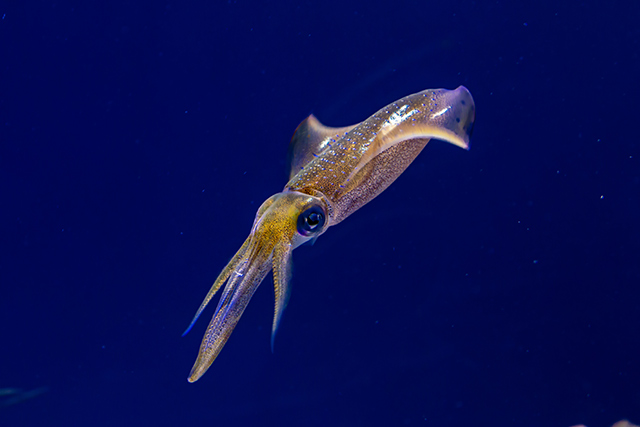
Without exception, cephalopods are active predators that have the ability to locate and capture prey, which demands some sort of reasoning power.
There are more to squids than meets the eye: They are known to be able to count, solve problems, recognize patterns and even communicate through a number of signals.
How they see remains a mystery because they are technically colorblind. However, they do seem to perceive color in some way, as they instantly change colors on the upper and lower bodies to blend into different backgrounds or attract potential mates. This complex behavior has also drawn intense interest in researchers over the years.
Neurobiologist Wen-Sung Chung of the University of Queensland in Australia said that these cephalopods are approaching the complex brains of dogs, and are surpassing mice and rats, at least in neuronal number.
"For example, some cephalopods have more than 500 million neurons, compared to 200 million for a rat and 20,000 for a normal mollusk," she said.
Squid brains, in particular, are known to be nearly as complex as dog brains, according to researchers. Using high-resolution MRI and various staining techniques, researchers discovered and described previously unknown major neural pathways in squids.
Cephalopod intelligence complexity
The complexity of cephalopod intelligence is fascinating. "These creatures are vision-dominant predators, and almost all coastal species are masters in doing dynamic coloration and camouflage based on direct control of the chromatophore cells all over the skin," Chung said.
"One very famous case is about their visual communication during mating competition. Males can display a ‘skin powered’ alphabet and have physical fights to compete for the mate."
Squids can even say "I love you" to their favorite partner, but using different ways. While it is certainly not an "instinct reflection," they have a very complex cognition process in their brain.
Setting out to map neural connections, Chung and her team turned to MRI. While these advanced tools and imaging techniques have been largely developed for the vertebrate model animals, they have adapted the ideas and techniques from mouse brain research and modified the machines to make the first high-resolution squid brain imaging work.
They found that some cephalopods have over 500 million neurons. In comparison, a rat has 200 million, but ordinary mollusks only have 20,000. This number is more similar to what is contained in a dog's brain. (Related: Study shows cuttlefish can also pass "marshmallow test" designed for children.)
"We can see that a lot of neural circuits are dedicated to camouflage and visual communication, giving the squid a unique ability to evade predators, hunt, and conspecific communicate with dynamic color changes," the scientists said.
The study also showed that the cephalopod nervous systems have independently evolved similarly to vertebrate central nervous systems, supporting current hypotheses around convergent evolution.
Chung noted, "This was the first step to having a structural connection map in a squid brain. This will help scientists target some specific brain lobes or regions to investigate how these apparently smart animals, but ancient mollusks, evolve to these abilities."
Chung and her colleagues want to look at a comparison of the brain architecture among cephalopods in the future, including the vampire squid, solitary octopus, paired-bond octopus, cuttlefish, and other rare deep-sea squids to see if their brains evolved according to their ecosystem.
See cephalopod intelligence yourself by watching the video below:
This video is from the Ozzy Man Reviews 2.0 channel on Brighteon.TV.
Read more about interesting animal discoveries at WeirdScienceNews.com.
Sources include:
Please contact us for more information.























